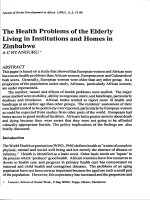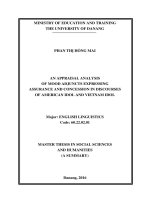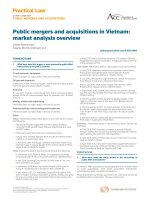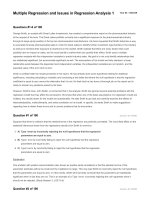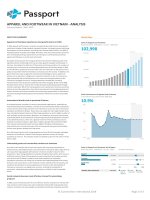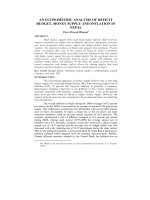SITUATION ANALYSIS: MANGROVE COMMUNITIES, MARKETS, STAKEHOLDERS, INSTITUTIONS AND POLICIES IN VIETNAM - Full 10 điểm
Bạn đang xem bản rút gọn của tài liệu. Xem và tải ngay bản đầy đủ của tài liệu tại đây (1.18 MB, 41 trang )
Situation Analysis:
mangrove communities, markets,
stakeholders, institutions and
policies in Vietnam
Stuart W Bunting1
1Centre for Environment and Society, Department of Biological
Sciences, University of Essex, Colchester, UK
Centre for Environment and Society Back to Office Report 2007-SWB2,
University of Essex, Colchester UK
Citation: Bunting, S.W., 2007. Situation Analysis: mangrove communities, markets,
stakeholders, institutions and policies in Vietnam. Centre for Environment and Society
Back to Office Report 2007-SWB2. University of Essex, UK.
Author contact details:
Centre for Environment and Society
Department of Biological Sciences
University of Essex
Colchester CO4 3SQ
UK
Email:
Acknowledgement and disclaimer:
This report is an output of the MANGROVE project which received research funding from
the European Community’s Sixth Framework Programme [Contract: INCO-CT-2005-
003697]; this publication reflects the author’s views and the European Community is not
liable for any use that may be made of the information contained herein.
© The author retains the copyright to materials presented in this report
ii
Glossary
ADB Asian Development Bank
CBO Community Based Organisation
CP Communication Plan
DFID Department for International Development (UK Government)
DoE Department of Environment
DoF Department of Fisheries
EC European Commission
FAO Food and Agriculture Organization (UN)
IUCN International Union for Conservation of Nature and Natural Resources
IWMI International Water Management Institute
KAP Knowledge Attitudes and Practices
MANGROVE Mangrove ecosystems, communities and conflict: developing knowledge-
based approach to reconcile multiple demands (EC project)
MERD Mangrove Ecosystem Research Division
NGO Non-Government Organisation
NR Natural Resources
NRSP Natural Resources Systems Programme
PAP Participatory Action Planning
PAPD Participatory Action Plan Development
PU-PAPi Peri-Urban Participatory Action Planning and Implementation
STEPS Social, Technical, Environmental, Political, Sustainability
UN United Nations
UNCDF United Nations Capital Development Fund
UNDP United Nations Development Programme
WB World Bank
WWF World Wildlife Fund
iii
Contents
Section Heading Page
Glossary iii
1 Introduction 1
2 Progress review - Vietnam National University 1
3 Site selection 1
4 Stakeholders 2
4.1 Stakeholder terminology 3
4.2 Stakeholder analysis 4
5 Institutional Analysis 5
5.1 Agreed Institutional Analysis outline 6
6 Participatory Community Appraisal and Rapid Rural Appraisal 7
7 Markets 7
8 Activities to finalise WP1 commitments 10
8.1 Agreed forward work plan 10
9 Preparation for P2 reporting 15
References 16
Annex 1 Work programme & Workpackage 1 – Situation Analysis outline presentation
Annex 2 VNU progress report presentation
Annex 3 Situation Analysis, Institutional Analysis and Site selection review
Annex 4 Tools and approaches for stakeholder analysis and interaction in mangroves and
adjacent coastal areas
Annex 5 Some experience from education activities on mangrove protection in coastal
areas, Vietnam
Annex 6 Draft news item for MANGROVE website
Annex 7 Reporting checklist for MANGROVE partners
Annex 8 Schedule of meetings Hanoi 3rd - 10th Feb 2007
Tables and Figures
Object Heading Page
Table 1 Selection criteria for the field site in Vietnam 2
Figure 1 Venn diagram showing relationships between stakeholders 4
Table 2 Marketing checklists developed during the INCO-DEV PAPUSSA project 8
Table 3 Agreed timeline for MERC and CERE activities 11
iv
1. Introduction
Situation Analysis (WP1) objectives stated in the project proposal are to: complete a
multidisciplinary situation appraisal of mangrove ecosystems at sites in Indonesia,
Thailand and Vietnam; raise awareness of their role in poor livelihoods; conduct an
institutional analysis. The Situation Analysis commenced at the start of the project in
August 2005 and background information collated and presented at the project inception
meeting in Bangkok, November 2005. However, owing to the delay in fully implementing
the project owing to the withdrawal of one partner the completion of this phase of work,
planned for March 2006, was significantly delayed. Having taken into account the delay in
project implementation and the dispersal of funds it is considered reasonable to expect that
this phase of the project will now be completed in June 2007. An overview presentation
concerning the status of the project, proposed work plan and detailed description of
Workpackage 1 – Situation Analysis was presented to the MERD team at the start of the
visit (Annex 1).
2. Progress review - Vietnam National University
During the inception workshop members of the Vietnam National University team gave
presentations on the current status of mangroves in Vietnam (MANGROVE Project,
2005). Appropriate study sites were proposed based on mutually agreed selection criteria
and stakeholder groups associated with the sites identified and their positions and
relationships explored; institutional, legal and policy frameworks were discussed. During
the PMG and Project Inception meeting 2 members of the VNU team participated in
planning WP1, 2, 3 and 4 activities. As with other partners, VNU faced a significant delay
in implementing fieldwork activities owing to the withdrawal of a partner jeopardising the
project. Despite this it was possible to retain the core of the team and to make further
progress on collating background information and data, as well as developing contacts
with other university faculties and Hanoi University of Education, Hanoi. Following the
decision to disperse the pre-financing payment to the consortium the Coordinator at VNU
undertook to find replacement team members and new appointments have been made. An
overview of progress was presented to the coordinator by the VNU team (Annex 2).
3. Site selection
Cognisant of changing circumstances since the project inception meeting, criteria
developed to assess the suitability of potential study sites (Table 1) were reviewed and the
1
earlier assessment and site selection reconsidered. Having reviewed the situation again it
was apparent that, based on criteria agreed by the consortium at the Project Inception
Meeting in Bangkok i.e. the significance of the remaining mangrove area, associated
livelihoods, ecosystem services provided, existing knowledge and logistics, Nam Dinh still
represented the most promising study site for the MANGROVE Project. However, owing
to recent development and a significant increase in research activity in the proposed Nam
Dinh National Park and Ramsar site area, it was decided to shift the focus of research in
the MANGROVE Project to the adjacent Tien Hai Nature Reserve.
Table 1. Site selection criteria for the field site in Vietnam
Criteria Quang Hai Nam Can Gio Ben Tre Ca Mau
Ninh Phong Dinh 3
4
Existing knowledge/data 3 4 5 5 3 2
2
Significance 3 4 5 5 4 5
Livelihood 2
Typhoon buffer 5 5 5 3 3
4
4 5 5 2 2 2
3
Carbon sink /accumulation 3 3 3 5 5 4
13
Replanting ages 3 3 4 5 4
Logistics
Permission 4 4 5 5 4
Travel 3 4 4 3 2
Communication 3 4 4 4 2
Existing projects 2 3 5 4 3
Total 12 15 17 16 11
Note: preliminary identification: 5, very high; 4, high; 3, average; 2, low; 1, very low.
4. Stakeholders
Several user groups, civil society groups, CBOs, NGOs, local and national government
departments associated with mangroves and adjacent coastal areas were identified during
the project inception meeting (MANGROVE Project, 2005). This section aims to provide
some guidance on how these groups, collectively referred to as stakeholders, can be
further differentiated and their positions and relationships explored, highlighting areas of
conflict and tension that the project team can subsequently work to resolve. Within this
strategy the concept of engagement is central; DFID (2001) described the nature of
engagement as:
2
‘Involving those who stand to win or lose from policy or institutional reform, or
who may influence the reform process, helps to make the interests of key
stakeholders transparent and to build ownership of the reform process.’
4.1. Stakeholder terminology
Basic terminology draws on the DFID Sustainable Livelihoods Guidance Sheets (DFID,
2001) where primary stakeholders are the intended beneficiaries of reform and key
stakeholders are those who can influence the outcome of the reform process1. Within the
category of key stakeholders it has sometimes been found useful to differentiate further
between secondary and tertiary stakeholders - based on geographic scale, management
role and interest. Stakeholders have been further categorised by various authors and
authorities, for example, Grimble (1998) described direct stakeholders as being ‘those
involved with the causes or consequences of a problem or issues and affected by actions
taken to alleviate in’ and indirect stakeholders as those ‘who can positively or negatively
influence the process and can play a role in strategies to solve the problems’.
Perhaps practical sometimes to categorise stakeholders in broad, unsophisticated
hierarchies, as in some aspects of the MANGROVE Project proposal, this is a shortcoming
that demands consideration. Such an approach fails to acknowledge the capabilities of
poor and vulnerable people (excluding perhaps poorest of the poor) to influence livelihood
outcomes. As Chambers (2005) says ‘The challenge is how to give voice to those who are
left out and to make their reality count’. Furthermore, although not wishing to perpetuate
divisive patron-client relationships, Chambers (2005) noted that ‘The tendency for local
elites to capture projects and programmes and use them for their own benefit should
indeed by recognized as a fact of life.’ Dealing with such realities and understanding the
roles of leadership, patronage, unions, political parities and frequently coercion and
extortion, may present opportunities to achieve more effective implementation and
sustainable livelihoods enhancements for poor people (Bunting, 2006). Discussing the
probability that local elites will monopolise initiatives, Chambers (2005) comments:
1 Reference to beneficiaries implies passive receipt of aid or assistance from a benefactor or supporter, this
feels at odds with the concept of participatory action and learning. Similarly, reform invokes a sense of
fundamental reorganisation, root and branch reform, whereas the actual outcomes might be more subtle.
3
‘there are benefits as well as costs in this. Leaders are often leaders because they
have ability, and projects may be better managed through their participation.
Leaders, especially where there is an active political party, may seek support and
legitimacy and so have an incentive to spread the benefits of projects to more
rather than fewer people.’
4.2. Stakeholder Analysis
Five elements constituting a situation analysis were outlined in the DFID Sustainable
Livelihoods Guidance Sheets (DFID, 2001) thus:
- identify and define level of influence of primary stakeholders,
- identify and define characteristics of key stakeholders,
- assess manner in which they might affect or be affected by reform,
- understand relations between stakeholders, including real or potential conflicts and
expectations between stakeholders,
- assess capacity of different stakeholders to influence reform process.
Considering urban governance, Rakodi and Lloyd-Jones (2002) proposed that the
relationship between stakeholders could be represented using a Venn diagram (Figure 1).
Figure 1. Venn diagram showing relationships between stakeholders (source Rakodi and Lloyd-Jones, 2002)
4
Martin et al. (2001) proposed a series of approaches to identify and explore stakeholder
interests:
- small meetings with a few key stakeholders where other stakeholder groups are
identified,
- stakeholder workshops to facilitate detailed exploration of activities, interests,
contributions and opportunities for new networks, with information tabulated or
represented using Venn diagrams (Figure 1)
- individual interviews with representatives of the main stakeholder groups, to discuss
issues, perceptions, constraints and significant in relation to the MANGROVE Project
objectives, potential areas of conflicts
- in-depth discussions with separate stakeholder groups
- joint focus groups with representatives of each stakeholder groups, to discuss issues
arising from earlier meetings and develop a strategic vision for uptake promotion with
policy makers.
Within the various framework proposed above it is important to remember that policy
makers are stakeholders too, and that their involvement is critical in developing a strategic
vision. It is important to engender ownership of the process as policy-makers are unlikely
to adopt an innovative strategy developed by other stakeholders in isolation. However,
where it is difficult to involve policy-makers, an autonomous initiative to plan and resolve
tensions would probably gain recognition, and if it were sufficiently representative and
authoritative would be difficult to ignore. The outline of the Stakeholder Analysis was
presented to the VNU team and discussed at length (Annex 3) as were participatory
research tools that might prove useful when working in physically, socially and
institutionally complex coastal settings (Annex 4).
5. Institutional Analysis
Referring to the project proposal a number of objectives were set out for the institutional
analysis and associated policy review activities described within the broader Situation
Analysis. The first step is to identify and describe institutions, including their motivations
and agendas. Having identified the various groups the next step is to sketch out the
relationships between groups, possible presenting this with a Venn diagram or matrix.
Legal frameworks and the policy process, including policy-making and policy statements,
5
will also be reviewed and potential linkages with planned project activities highlighted.
Critical in several cases will be an assessment and understanding of the interaction
between local and centralised decision-making.
5.1. Agreed Institutional Analysis outline
Meet key stakeholder representatives to discuss mangrove management and planning:
- define their role/responsibilities/influence
- identify principles/planning framework/legislation/etc…that guides decision-making
- give emphasis to issues relevant to coastal livelihoods: classification of activity,
zoning, relevant legislation, references to livelihoods in official documentation,
- define the priority of mangrove conservation with respect to other activities
- elicit perceived constraints to mangrove conservation and wise use
- investigate initiatives to address these problems
- discuss the perceived benefits of mangrove conservation and wise use
- discuss historical land-use change that has impacted on mangrove area and discuss
future prospects in light of planning initiatives, state level development objectives,
globalization, international agreements, climate change
Describe actor/stakeholder roles in managing coastal natural resources and in guiding the
formal land-use planning process, including their jurisdiction, sphere of influence and their
position within the overall hierarchy. Furthermore, identify strategically significant user
groups, institutions or committees, and individuals therein, that guide and influence policy
formulation.
Develop the management/planning hierarchy to include landowners, leaseholders,
community management bodies and employees and their power, influence and roles.
Assess the knowledge needs of key actors/stakeholders interviewed and the most
appropriate pathways for disseminating project outputs i.e. workshop participation,
technical reports, media communications. VNU presented a summary of key work
undertaken concerning education activities focused on mangrove protection (Annex 5).
6
Assess the potential role of strengthened civil society groups, producer associations and
more informed advocates for the poor and local planners in developing appropriate
management/development strategies for mangroves and adjacent coastal areas.
Develop a work programme to assess systematically the priority assigned by different
institutions to mangrove conservation and wise use, constraints and opportunities
associated with these practice and strategies to manage these systems equitably
Report back on findings at stakeholder forum for verification and triangulation
6. Participatory Community Appraisal and Rapid Rural Appraisal
Capacity building workshops focused on Sustainable Livelihoods Analysis and
Participatory Rural Appraisal were planned for each project site, the intention being to
enhance the skills of project staff tasked with fieldwork, and to involve other stakeholder
groups so as to raise their awareness, initiate a constructive dialogue and begin to
engender a sense of ownership (Ha et al., 2006). The workshop was completed in Vietnam
and a workshop report has been published (STREAM, 2006).
7. Markets
Conventional market transactions should be assessed at each stage in the marketing
network, from producer, collector or harvester to consumer or user. The first step is to
assess what products, derived directly and indirectly, from mangrove areas are being
marketed. This might best be facilitated through interviews with key informants or through
participatory activities such as resource mapping, seasonal activity and income calendars,
stakeholder analysis, or ideally a combination of the two. A simple checklist might be
invoked to guide the assessment, as was the case in the previous INCO-DEV PAPUSSA
project (Table 2). Key elements assessed at each stage in the marketing network included
product, quantity, source, pre-harvest and post-harvest handling, buyer types, nature of the
transaction, administration, legislation and licensing, overall number or proportion of
traders dealing in aquatic foods, seasonal changes, trends and additional data.
7
Table 2. Marketing checklists developed during the INCO-DEV PAPUSSA project
Checklist of topics to discuss: Collectors Wholesale Wholesalers Collectors Retail market Retailers Consumers
market management
management
Quantity – Spp. / price Volume traded Spp. price Buy/sell price
bought/sold/transported/traded Quantity/day Organisation per day / price Quantity/day Spp./ quantity
per day
Source: where from, rural or Which district/ Bought from Where – Where
peri-urban, distance/travel cost, province? where? Rural/PU province Rural/PU-
when collected Rural/PU- Distance – when Rural/PU- distance-when
distance- delivered distance- collected/deliver
Pre-harvest and post-harvest when/how /collected (time) when/how ed/wholesaler/pr
handling collect/deliver collect/deliver oducer
Types of buyer - rich / poor Processing & Processing & Processing & Methods
preservation preservation preservation
Transactions e.g. contracts Products sold Products sold Products sold Products sold Occupation
where? where? where? where? Age range
How many Bought from How many How many
permanent & collector or permanent & Organisation permanent &
temporary producer? How temporary temporary
contracts many permanent contracts Tax contracts – any
How often do & temporary How often do Type of admin relationship with
you collect? contracts with you collect? fee? sellers/buyers?
sellers/buyers Institutional No. of buyers on
arrangements average?
Administration fee Tax Tax Tax Tax Is a licence
Legislation/ licence Type of admin Type of admin Type of admin Type of admin required? Is a licence
fee? fee? fee? fee? No. of retailers at required?
Number/ proportion of traders Any licence/ Institutional Do you require a Any licence/ market
dealing in aquatic foods legislation? arrangements licence? legislation?
Is a licence
No. of collectors required? No. of collectors
No. of
wholesalers at
market
8
Seasonal changes: quantity and Any change due Any change due Any change due Least / most
price to seasonal to seasonal to seasonal consumed
Constitutes, timeline, trend and variation? variation? variation? Any change due
choice Quantity/price/ Quantity/price/ Quantity/price/ to seasonal
Spp. etc. Spp. etc. Spp. etc. variation?
Quantity/price/
Additional data collection Production in Start date? Do you employ Production in Start date? Spp. etc. What fw
proposed for ww region? Home of anyone/use ww region? Home of Any trend in products do you
Are you also wholesalers? family members? Other important retailers? buying apparent? buy?
wholesaler/ Other important Other important information? Other important Which Spp. Spp. most liked?
retailer? information? information? Difficulties/ rec- information? preferred by Size you like?
Do you employ Difficulties/ rec- Difficulties/ rec- ommendations? Difficulties/rec- buyer? Concerned about
anyone/use ommendations? ommendations? ommendations? Other important price?
family members? information? Why do you like
Other important Difficulties/rec- to eat this fish?
information? ommendations? [combined in
Difficulties/ rec- matrix]
ommendations? Other problems?
9
Commodities might be traded on a local, regional, national or international basis and this
will have implications for the health and wellbeing of both producers and consumers; the
balance of trade against subsistence needs also demands consideration. Furthermore,
although perhaps not traded in formal markets, the supply and appropriation of
environmental good and services, or ecosystem services, derived from mangrove areas
should be considered; this should highlight indirect benefits accruing to poor and
vulnerable communities, and society more generally. Assessing ‘values’ attributed to
mangroves will provide a more comprehensive account concerning existing and potential
future benefits of conserving and restoring mangrove areas.
8. Activities to finalise WP1 commitments
Various reference have been gathered together by the VNU team, including workshop
proceedings, scientific papers and reports and training manuals from Government
Departments, proving a sound basis from which to compile the background to the
Situation Analysis report.
8.1. Agreed forward work plan
Following various discussions of the elements constituting the Situation Analysis, the
MERD team prepared a provisional work plan including background data collection and
collation, stakeholder and institution analysis, PCA fieldwork, market assessment, State of
the System (SOS) workshop and reporting (Table 3). The MERD team undertook to
provide regular updates on progress and the project coordinator undertook to assist in the
implementation of the work plan where possible.
10
Table 3. Agreed timeline for MERC and CERE activities
Main outputs Expected outputs Description Methods Mainly Date
Responsible 12-13/2/2007
Introduction of the Introduction of the project Meetings with local authorities 12/2-1/3/2007
project Prof. Hong,
Overview report on Background (geography, climate, Statistically collecting data, Dr. Tri 12/2-1/3/2007
Background on natural conditions, socio- population, coastal ecosystems, etc…) administrative map, population,
study site economics, mangrove climate, coastal ecosystems. Dr. Dao, 12/2-4/3/2007
ecosystem - general description Dr. Tuan, 10/3 – 20/3/2007
- Site selection (importance, logistics, MERD 20/3/2007 –
Overview report on the data, access) 1/4/2007
study site Collecting data on importance, 10/3 – 20/3/2007
logistics, data, access) of the study
site (province, district and 3
selected communes)
Report on Stakeholder Identify stakeholders (user groups, civil Dr. Dao,
analysis society, CBOs, NGOs, gov, others)
Dr. Tuan,
Surveys Stakeholder meeting MERD
individual interviews
Stakeholder analysis Analysis of surveyed data
Primary and Key? Stakeholder analysis
Primary, Secondary, Tertiary?
Institutional, policy
and legal analysis Surveys
Report on institutional Stakeholder meeting Dr. Dao,
analysis Ranking
Venn diagram Dr. Tuan,
individual interviews MERD
11
Identify and describe: Data analysis 20/3/2007 –
- institutions motivations Institutional analysis 1/4/2007
- relationships
Report on policy analysis - legal frameworks governing mangrove Individual interviews CERE (Dr. Tri) 10/3 – 20/3/2007
exploitation and management. Stakeholder meeting and Ph.D student
Ranking Tho (to be
Surveys confirmed)
Policy framework Data analysis 20/3/2007 –
x formulation Policy analysis 1/4/2007
x linkages
x interaction between local and Mapping CERE (Dr. Tri) 10/3 – 20/3/2007
Interview (key person, leaders,
centralised decision-making authorities, etc.)
Group meeting
Surveys (different target/gender groups) Ranking/Scoring
Data analysis
General report on Disaggregate community by wealth and Desk analysis 20/3/2007 –
livelihoods in association gender and focusing on livelihoods of 1/4/2007
with mangrove poor people Data analysis
conservation and Desk analysis 20/3/2007 –
rehabilitation weight / rank significance of good / 1/4/2007
services in livelihoods
Participatory
Community
12
Appraisal explore vulnerability (with focus groups Data analysis 20/3/2007 –
and household interviews and seasonal Desk analysis 1/4/2007
calendars)
Data analysis 20/3/2007 –
assess assets (natural, physical, financial, Desk analysis 1/4/2007
human, social)
Map spatial distribution - GIS CERE (Dr. Tri) 20/3/2007 –
of mangroves with - phân bӕ rӯng ngұp mһn liên quan vӟi - PRA (maping) 1/4/2007
secondary stakeholders các hoҥt ÿӝng cӫa ngѭӡi dân (thӫy sҧn, - Interview
nuôi vҥng, RNM…) - Data analysis
- dịng hàng hóa và dӏch vө trong cӫa
cӝng ÿӗng phө thuӝc vào RNM (direct
use, indirect use, ecosystems services)
Biogeochemical, Report on Biogeochemical, hydrological and Collect existing data and Prof. Hong, 20/3/2007 –
hydrological and Biogeochemical, ecological setting of mangroves indigenous knowledge MERD 1/4/2007
ecological setting of hydrological and (biogeochemical, hydrological,
mangroves ecological setting of
mangroves ecological)
Market analysis Report on market Surveys to fill gaps in the knowledge- Collect data/Group 10/3 – 20/3/2007
networks for goods (and base meeting/Interview Dr. Dao, MERD 10/3 – 20/3/2007
services) and assess Surveys
magnitude Interview 20/3/2007 –
Map market networks for goods (and Meetings 1/4/2007
services) and assess magnitude Ranking
Data analysis
Map making
13
Report on Market analysis Surveys Interview Dr. Dao, MERD 10/3 – 20/3/2007
Meetings
power relations, market forces and Ranking 20/3/2007 –
processes related to globalisation on 1/4/2007
ecosystem functioning, livelihood Data analysis
strategies and institutional arrangements Desk analysis
Gender analysis Report on Gender Surveys Gender group meeting CERE (Dr. Tri) 10/3 – 20/3/2007
Framework Analysis Ranking MERD, CERE
Workshop Address specific gender issues 20/3/2007 –
proceedings Data analysis 1/4/2007
Situation appraisal Workshop proceedings Present outcomes in workshops at each Desk analysis 13-18/5/2007
report Final report site with stakeholders (check and verify
findings) Hold a local workshop (1 -2 days)
Situation appraisal report Prof. Hong, Dr. 1/4 - 31/4/2007
Tri
- Extra surveys will be conducted during 8-14/4/2007
14
9. Preparation for P2 reporting
Based on the proposed timing of WP1 activities it was agreed that a joint consortium and
PMG meeting in June would be appropriate to review progress in each of the field sites and
plan WP3-5 activities in detail. This meeting would also provide an opportunity to review
reporting responsibilities and commitments and draft relevant report sections so that P2
reporting to the EC can be completed in a timely fashion. The second reporting period for the
project (P2) ends on the 31st July 2007, the deadline for submission of final reports to the EC
is 45 days later. A reporting checklist and timetable was revised based on discussions during
the week (Annex 7) and will be circulated to the project consortium using the MANGROVE
Project email list managed by NACA.
15
References
Bunting SW (2006) Low impact aquaculture. Centre for Environment and Society Occasional Paper
2006-3. University of Essex, UK.
Chambers R (2005) Ideas for Development. Earthscan, London.
DFID (2001) Sustainable livelihoods guidance sheets. Department for International Development,
London, UK.
Grimble R (1998) Stakeholder methodologies in natural resource management. NRI, University of
Greenwich, UK.
MANGROVE Project (2005) Inception workshop proceedings. NACA, Bangkok. (online at:
www.streaminitiative.org/Mangrove)
Martin A, Oudwater N, Gundel S (2001) Methodologies for situation analysis in urban agriculture.
Synthesis Paper for workshop on ‘Appropriate Research and Planning on Methodologies for urban and
peri-urban agriculture’ 2-5 October 2001, Nairobi, Kenya. ETC, CGIAR, UNDP-UNCHS.
Ha NS, Tran NM, Smith E, Suspita A, Haylor G (2006) Capacity building on sustainable livelihoods
analysis and participatory rural appraisal. Working Paper NSH1: EU Project MANGROVE INCO-CT-
2005-003697. STREAM/NACA, Hanoi, Vietnam.
Rakodi C, Lloyd-Jones (2002) Urban Livelihoods. Earthscan, London.
STREAM, 2006. Workshop on capacity building for situation analysis of mangroves ecosystem and
communities. Hanoi and Nam Dinh, Vietnam, 4-8 December 2006. (online at:
www.streaminitiative.org/Mangrove)
16
